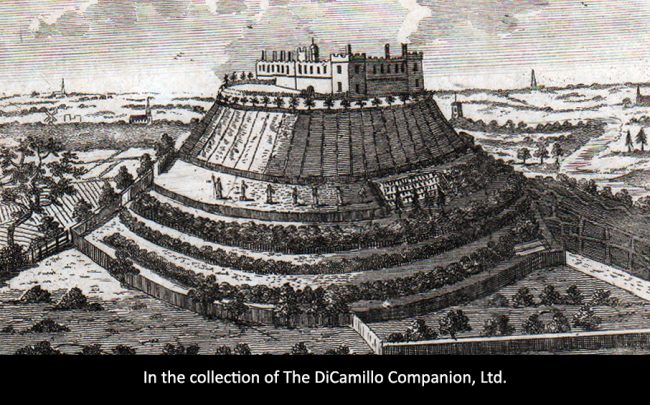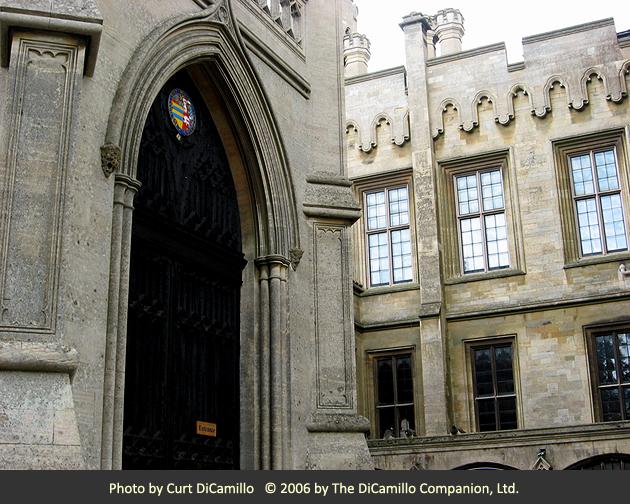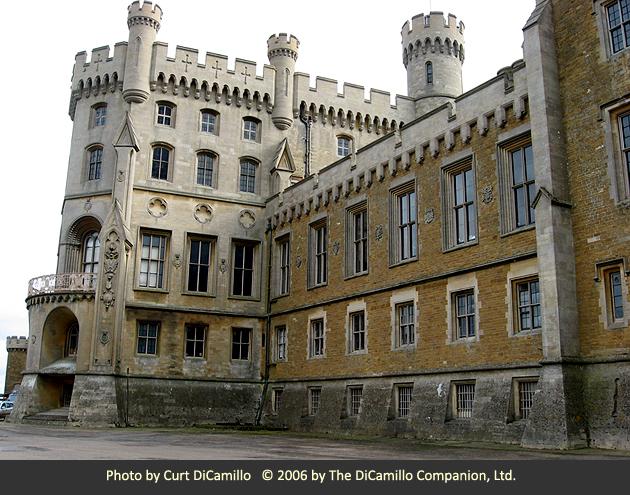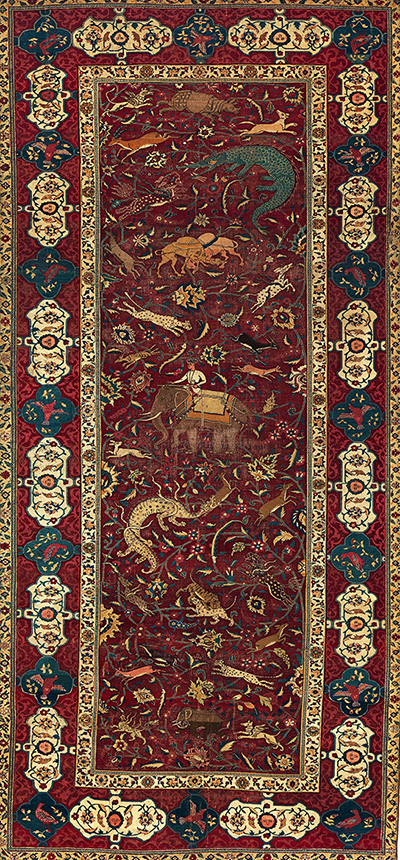
The House from "Morris's Views of Seats," 1880s.

The Castle from a circa 1950s Johnson Brothers plate from the Old Britain Castles in 1792 series

The House as seen in the 17th century, from an 1804 copperplate engraving from 'ngland Delineated.'






The Rose Garden


Scenic Animal Carpet. Indian, Circa 1625. Widener Collection, National Gallery of Art, Washington. This image is in the public domain.
Earlier Houses: At least two earlier buildings existed on the site: a Norman castle and a 16th century house, bits and pieces of which were incorporated into the current castle.
House & Family History: The name of the castle, meaning "beautiful view" in French, dates to a famous Norman castle built in the 11th century by Robert de Todeni (later Robert de Belvedeir), standard bearer to William the Conqueror. This castle was mostly destroyed by Lord Hastings in the 15th century during the Wars of the Roses and remained ruinous for years. Belvoir was rebuilt in the 16th century by the 1st Earl of Rutland, using stone from the recently dissolved Croxton Abbey and Belvoir Priory. This castle was also destroyed—this time in 1649, as part of a siege by Parliamentarians during the English Civil War (during the war Belvoir was a notable stronghold of the king's supporters; Charles I spent a night here on his way into Lincolnshire during the Civil War). The castle was rebuilt again in the 1650s and 1660s, after which it was noted for its plantations on the top of the hill (see engraving in the "Images" section). Today's Belvoir, complete with 1,200 windows, is mostly a 19th century creation. Based on the 17th century castle, and incorporating parts of the earlier castles, this romantic 19th century building was commissioned by Elizabeth, 5th Duchess of Rutland (1780-1825). Initially erected to the designs of James Wyatt, the first creation was virtually destroyed by the catastrophic fire of October 26, 1816; after the fire, members of Wyatt's family (James Wyatt had died in 1813) came together to create the Belvoir of today. All over this was overseen by the 5th Duchess, who tragically didn't live to see the finished interiors. Her husband named the grandest of these new rooms, the Louis XIV style Elizabeth Saloon, in her memory. The convicted war criminal Hermann Göring, reichsmarschall and Hitler's Luftwaffe head, supposedly planned to requisition Belvoir as his English hunting lodge after the Nazi invasion of Britain. Belvoir is at the center of Catherine Bailey's 2012 book, "The Secret Rooms: A True Story of a Haunted Castle, a Plotting Duchess, and a Family Secret."
Collections: Belvoir contains canvases by Poussin, Holbein, Rubens, Reynolds, and an interesting 1671 painting of Cheveley Park (a now-demolished former seat of the dukes of Rutland) by Jan Siberechts. The collection also includes Gobelins and Mortlake tapestries, Chinese silks, furniture, porcelain, and sculpture. The devastating October 26, 1816 fire destroyed 115 paintings, including works by van Dyck, Poussin, Rubens, Reynolds, and Titian. Belvoir once contained a famous series of paintings by Nicholas Poussin entitled “The Seven Sacraments.” Painted between 1637 and 1640, the series was purchased by the 4th Duke of Rutland in 1784. “Penance” was destroyed by the famous 1816 fire; in 1939 “Baptism” was acquired by the National Gallery of Art, Washington; in 2011 “Ordination” (see “Images” section) was purchased by the Kimbell Art Museum, Texas, for $24 million; “Extreme Unction” was sold by the 11th Duke in 2013 to the Fitzwilliam Museum, Cambridge. The remaining three (“Eucharist,” “Confirmation,” and “Marriage”) are today in the collection at Belvoir. The Rutland Psalter was sold to the British Museum in 1984. An exceptionally fine circa 1625 Indian scenic carpet, formerly at Belvoir, is today in the Widener Collection, National Gallery of Art, Washington (see "Images" section).
Comments: Pevsner called Belvoir "...much the beau ideal of the romantic castle." In 1846 "White's Directory" cited Belvoir as "by far the most superb architectural ornament of which Leicestershire can boast."
Garden & Outbuildings: The Statue Gardens were constructed into the hillside below the castle and named after the 17th century sculptures on display. Thomas Barlow designed the stables for 1st Duke of Rutland. The Belvoir Estate today comprises approximately 20,000 acres.
Architect: Matthew Cotes Wyatt
Date: Circa 1820-30Architect: John Thorpe
Date: 17th centuryArchitect: John Webb
Date: 1655-68Architect: Benjamin Dean Wyatt
Date: Circa 1820-30Architect: Thomas Barlow
Date: Early 18th centuryArchitect: James Wyatt
Date: 1801-13Architect: Jeffry Wyatville (Wyattville) (Wyatt)
Date: 1816Vitruvius Britannicus: C. IVth. pls. 47-50, 1739.
John Bernard (J.B.) Burke, published under the title of A Visitation of the Seats and Arms of the Noblemen and Gentlemen of Great Britain and Ireland, among other titles: Vol. II, p. 61, 1853.
John Preston (J.P.) Neale, published under the title of Views of the Seats of Noblemen and Gentlemen in England, Wales, Scotland, and Ireland, among other titles: Vol. II, 1819.
Country Life: XCI, 851 [Plate], 1036 [Plate], 1130 [Plate], 1942. CXX, 1284, 1402 plan, 1456, 1500, 1956.
Title: Belvoir Castle: 1,000 Years of Family, Art and Architecture
Author: Duchess of Rutland
Year Published: 2009
Reference: pg. 49
Publisher: London: Frances Lincoln Limited
ISBN: 9780711230521
Book Type: Hardback
Title: Biographical Dictionary of British Architects, 1600-1840, A - SOFTBACK
Author: Colvin, Howard
Year Published: 1995
Reference: pgs. 979, 1030, 1105, 1119
Publisher: New Haven: Yale University Press
ISBN: 0300072074
Book Type: Softback
Title: Movie Locations: A Guide to Britain & Ireland
Author: Adams, Mark
Year Published: 2000
Publisher: London: Boxtree
ISBN: 0752271695
Book Type: Softback
Title: Disintegration of a Heritage: Country Houses and their Collections, 1979-1992, The
Author: Sayer, Michael
Year Published: 1993
Publisher: Norfolk: Michael Russell (Publishing)
ISBN: 0859551970
Book Type: Hardback
House Listed: Grade I
Park Listed: Grade II*
Current Seat / Home of: David Charles Robert Manners, 11th Duke of Rutland; Manners family here since the 16th century.
Past Seat / Home of: SEATED AT EARLIER HOUSES: Robert de Todeni, later Robert de Belvedeir, 11th century. William d'Aubigny (Albanie), 13th century. Robert de Ros (Roo), 13th century. George Manners, 11th Baron de Ros, until 1513; Thomas Manners, 1st Earl of Rutland and 12th Baron de Ros of Helmsley; 1513-43; Henry Manners, 2nd Earl of Rutland and 13th Baron de Ros of Helmsley, 1543-63; Edward Manners, 3rd Earl of Rutland and 14th Baron de Ros of Helmsley, 1563-87; John Manners, 4th Earl of Rutland, 1587-88; Roger Manners, 5th Earl of Rutland, 1588-1612; Francis Manners, 6th Earl of Rutland, 1612-32; George Manners, 7th Earl of Rutland, 1632-41; John Manners, 8th Earl of Rutland, 1641-79; John Manners, 1st Duke of Rutland and 9th Earl of Rutland, 1679-1711; John Manners, 2nd Duke of Rutland, 1711-21; John Manners, 3rd Duke of Rutland, 1721-79; Charles Manners, 4th Duke of Rutland, 1779-87. SEATED AT CURRENT HOUSE: John Henry Manners, 5th Duke of Rutland, until 1857; Charles Cecil John Manners, 6th Duke of Rutland, 1857-88; John James Robert Manners, 7th Duke of Rutland, 1888-1906; Henry John Brinsley Manners, 8th Duke of Rutland, 1906-25; Captain John Henry Montagu Manners, 9th Duke of Rutland, 1925-40; Charles John Robert Manners, 10th Duke of Rutland, 1940-99.
Current Ownership Type: Individual / Family Trust
Primary Current Ownership Use: Private Home
House Open to Public: Yes
Phone: 01476-871-002
Fax: 01476-870-443
Email: [email protected]
Website: https://www.belvoircastle.com
Historic Houses Member: Yes